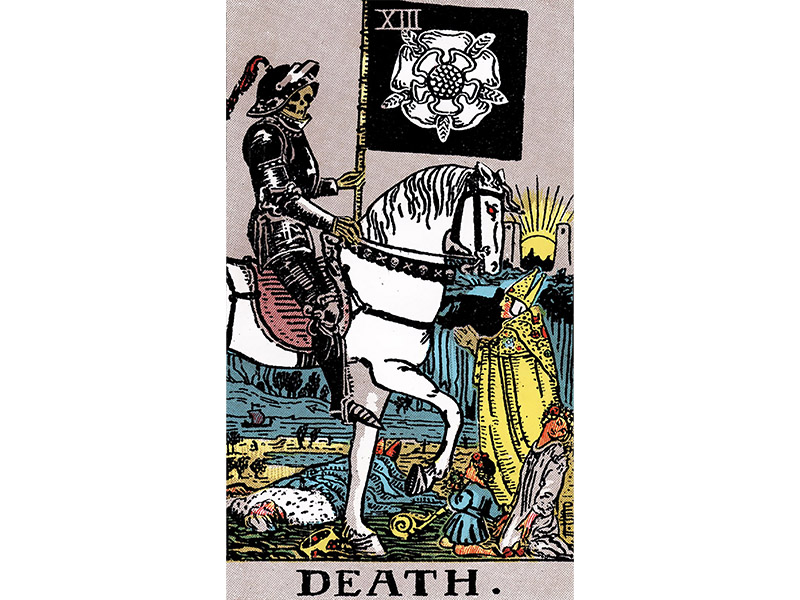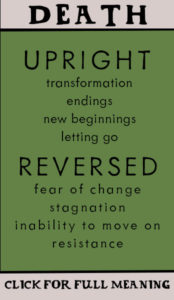Introduction
The Death card, numbered as XIII in the Major Arcana, is a symbol of transformation, renewal, and the natural cycle of life. As the fourteenth card in the Tarot’s Major Arcana, Death signifies the end of one phase and the beginning of another, reminding us that change is inevitable and often necessary for growth. In this article, we will explore the rich symbolism of The Death card, its upright and reversed meanings, and how it fits into the narrative of the Tarot.
Click the card meaning image to the left to view all pages tagged with Death.
The Death Card’s Imagery and Symbolism
The Death card is often depicted as a skeletal figure, usually riding a horse or standing with a scythe, surrounded by various figures representing different aspects of life. The card’s imagery is rich with symbolism that represents the themes of transformation, renewal, and the natural cycle of life.
Key symbols in the imagery of The Death card include:
- The skeletal figure: The skeletal figure in The Death card represents the idea of transformation and renewal, symbolizing the inevitable end of one phase and the beginning of another.
- The scythe: The scythe held by The Death figure represents the cutting away of the old to make way for the new, as well as the idea of harvesting the fruits of our past actions.
- The horse: The horse in The Death card symbolizes the unstoppable force of change, highlighting the idea that transformation is inevitable and often necessary for growth.
- The various figures: The figures surrounding The Death figure represent different aspects of life, reminding us that change affects everyone and is a natural part of the cycle of life.
Upright Meaning of The Death Card
When drawn upright in a Tarot reading, The Death card is a powerful reminder of the need for transformation, renewal, and the acceptance of change. It encourages us to let go of the old and embrace the new, recognizing that change is inevitable and often necessary for growth. Some of the key meanings associated with The Death card in its upright position include:
- Transformation: The Death card represents the end of one phase and the beginning of another, symbolizing the process of transformation and renewal.
- Letting go: The Death card encourages us to let go of the old and embrace the new, recognizing that change is inevitable and often necessary for growth.
- Acceptance of change: The Death card is a reminder to accept the natural cycle of life and to recognize that change is a normal part of existence.
- Rebirth: The Death card can also signify a period of rebirth or renewal, indicating that new opportunities and growth may arise from the end of a previous phase.
Reversed Meaning of The Death Card
When The Death card appears reversed in a reading, it may indicate feelings of resistance to change, stagnation, or an inability to let go of the past. Some of the key meanings associated with The Death card in its reversed position include:
- Resistance to change: The Death card reversed can signify a resistance to change or an unwillingness to let go of the past.
- Stagnation: The reversed Death card may suggest a feeling of being stuck or stagnant, possibly due to fear or an inability to accept change.
- Inability to let go: The Death card reversed can indicate an inability to let go of the past or to embrace transformation, potentially hindering personal growth.
- Fear of change: When The Death card appears reversed, it may be a sign that one is struggling with a fear of change or the unknown.
Conclusion
The Death card is a powerful symbol of transformation, renewal, and the natural cycle of life, encouraging us to accept change and embrace the new. Whether it appears upright or reversed in a Tarot reading, The Death card invites us to reflect on our attachments, our resistance to change, and our willingness to let go of the past in order to grow. By understanding the rich symbolism and meanings associated with The Death card, we can unlock the transformative power of this thought-provoking Tarot card and learn to embrace change and renewal in our daily lives.
Previous Card: The Hanged Man
Next Card: Temperance


